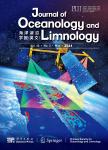Key physiological traits and chemical properties of extracellular polymeric substances determining colony formation in a cyanobacterium
Key physiological traits and chemical properties of extracellular polymeric substances determining colony formation in a cyanobacterium作者机构:Key Laboratory of Integrated Regulation and Resource Development on Shallow LakesMinistry of EducationCollege of EnvironmentHohai UniversityNanjing 210098China College of Hydrology and Water ResourcesHohai UniversityNanjing 210098China State Key Laboratory of Lake Science and EnvironmentNanjing Institute of Geography and LimnologyChinese Academy of SciencesNanjing 210008China
出 版 物:《Journal of Oceanology and Limnology》 (海洋湖沼学报(英文))
年 卷 期:2022年第40卷第5期
页 面:1720-1731页
核心收录:
学科分类:0710[理学-生物学] 0908[农学-水产] 0707[理学-海洋科学] 09[农学] 0815[工学-水利工程] 0903[农学-农业资源与环境]
基 金:Supported by the National Natural Science Foundation of China(No.32071569) the Scientific Instruments and Equipment Development Project Chinese Academy of Sciences,2020(No.YJKYYQ20200048) the Fundamental Research Funds for the Central Universities(No.B210202010) the China Postdoctoral Foundation(No.2020M681472)
主 题:colony formation physiological properties extracellular polymeric substances(EPS)composition cyanobacterial blooms
摘 要:Colony formation of cyanobacteria is crucial for the formation of surface blooms in ***,the underlying mechanisms of colony formation involving in physiological and cell surface characteristics remain to not well be *** cyanobacterial Microcystis strains(including both unicellular and colonial ones)were employed to estimate the influences of their physiological traits and the composition of extracellular polymeric substances(EPS)on colony or aggregate *** show that raising the number of the photosynthetic reaction center and light-harvesting antenna in the PSII and reducing the growth rate were the major physiological strategies of Microcystis to produce excess EPS enhancing colony *** bound EPS(T-EPS)was responsible for colony formation,which approximately accounted for 50%of the total amount of *** fluorescent components(protein-,tryptophan-,and tyrosine-like components and two humic-like components)were found in the T-EPS,although the amounts of these components varied with ***,colonial strains contained much higher tyrosine-like substances than unicellular *** suggest that tyrosine-like substances might serve as a crosslinking agent to connect other polymers in EPS(e.g.,proteins or polysaccharides)for colony *** findings identified key physiological traits and chemical components of EPS for colony formation in Microcystis,which can contribute to a better understanding on the formation of Microcystis blooms.



